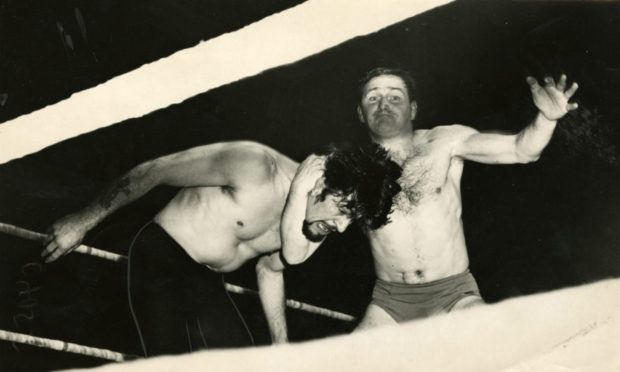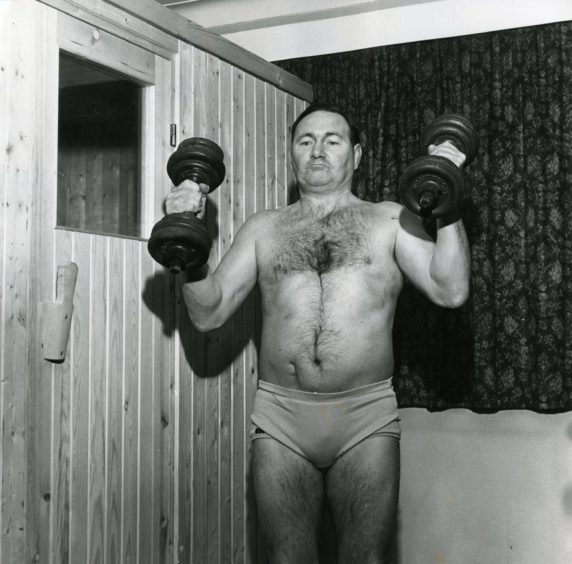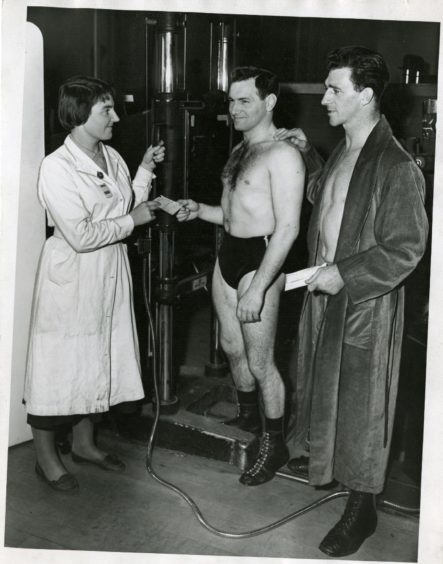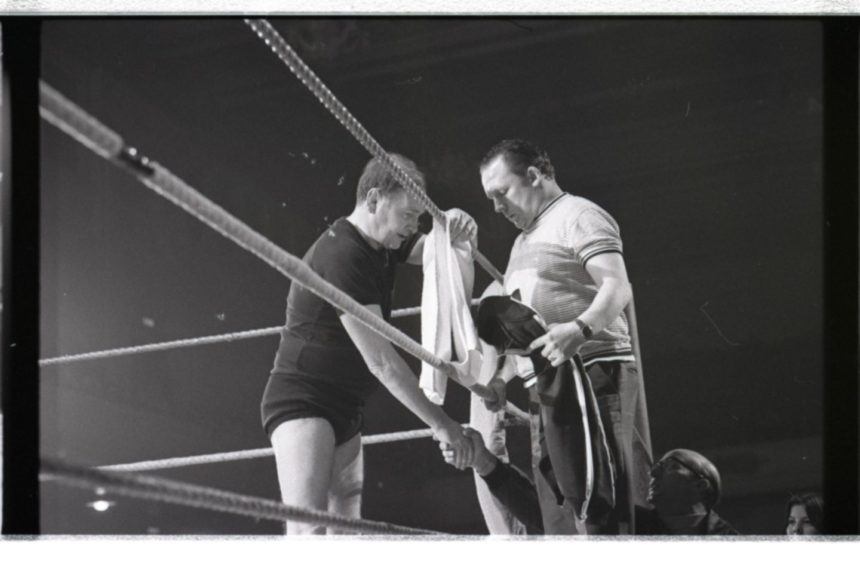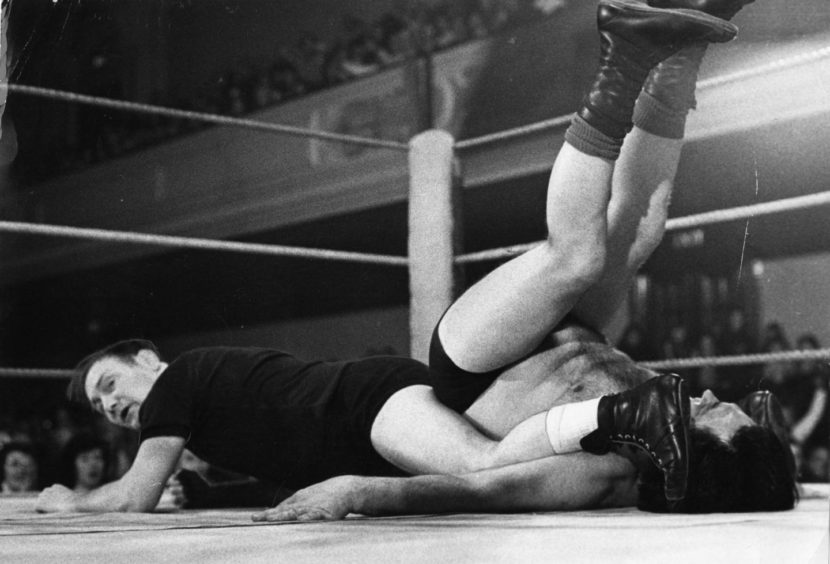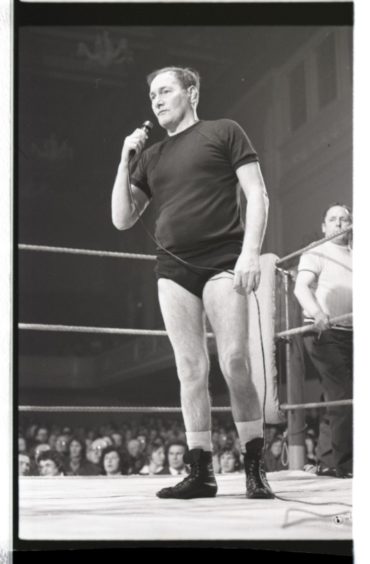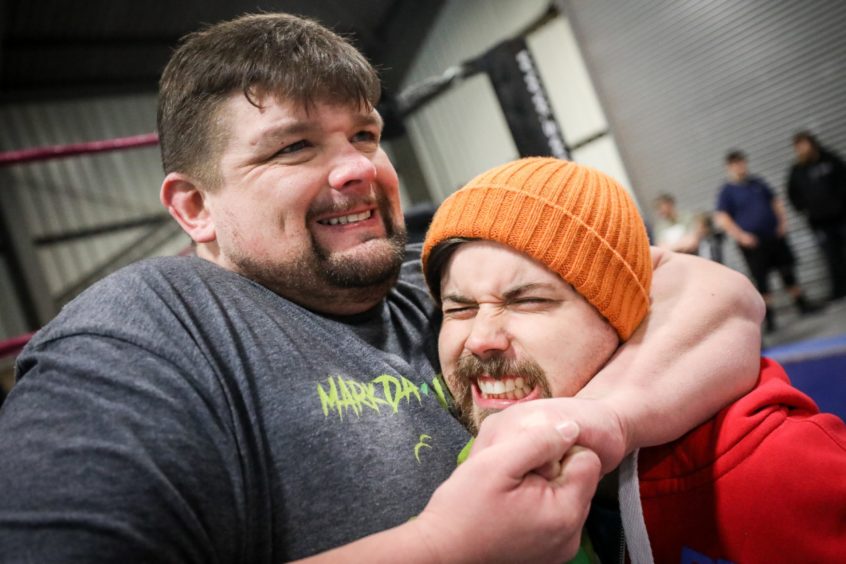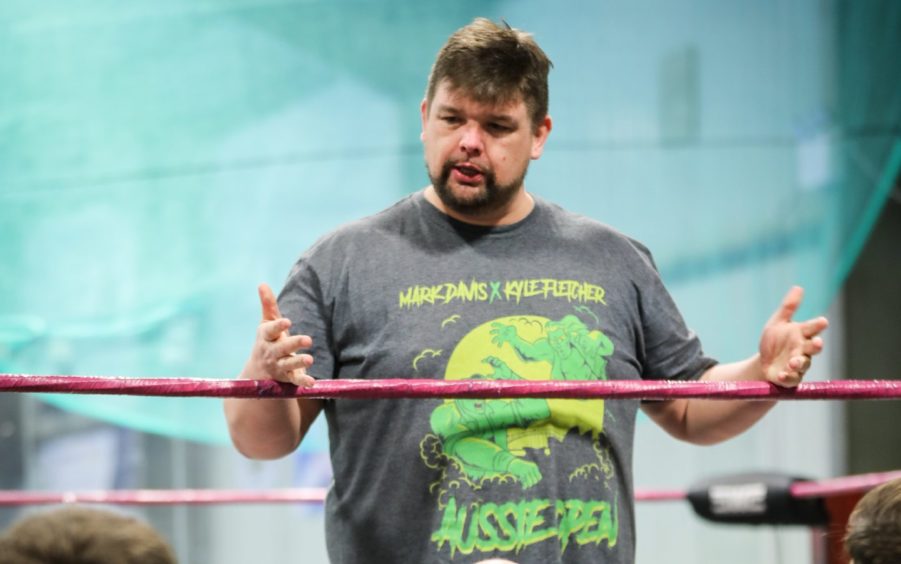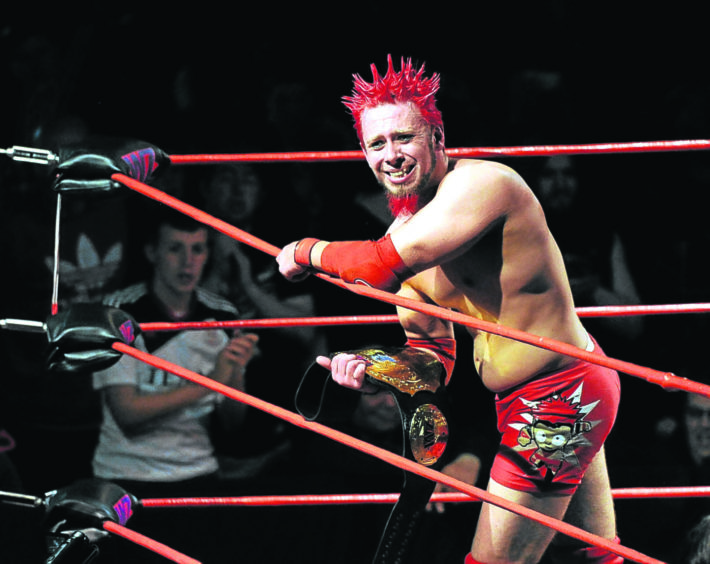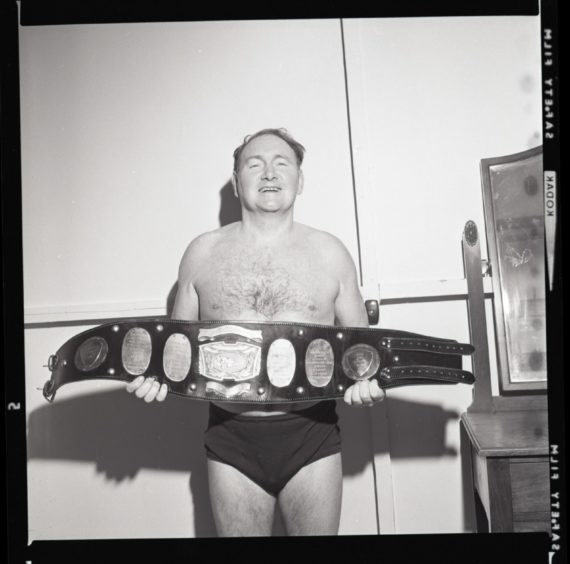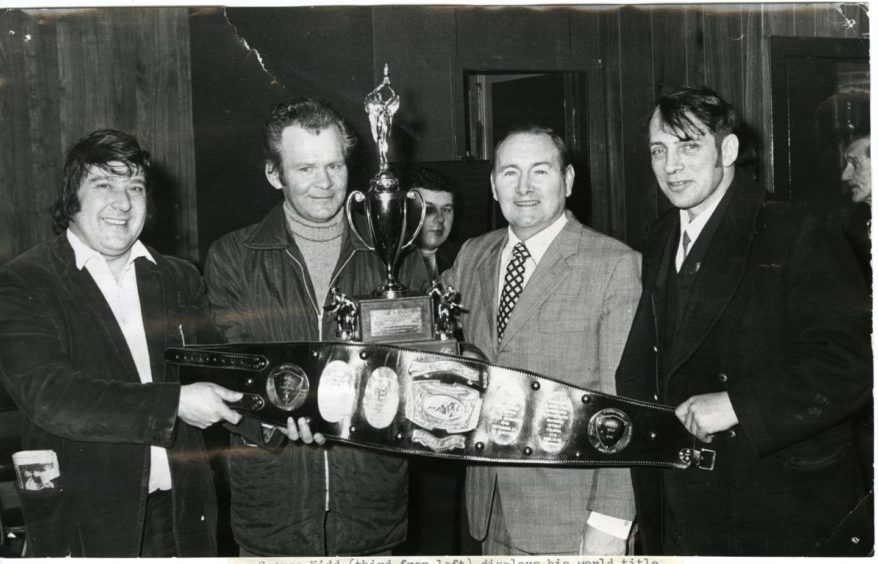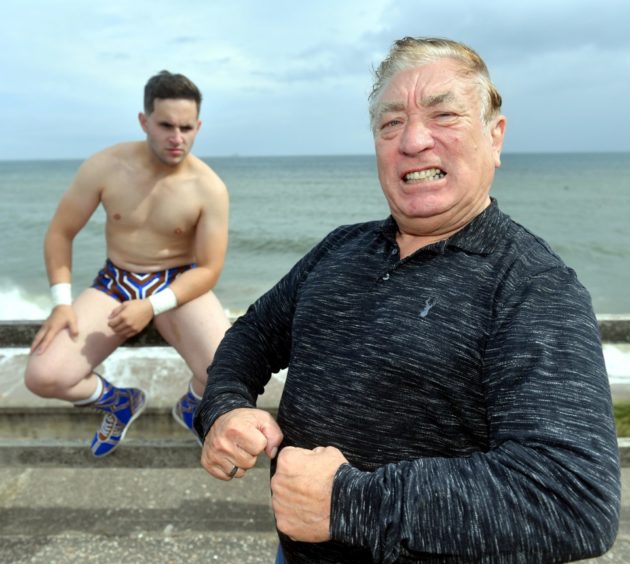It’s 45 years since legendary Dundee wrestler George Kidd, aka the Houdini of the mat, fought his very last fight. Gayle Ritchie looks at the life and legacy of one of Scotland’s greatest grapplers.
Revered by the wrestling fraternity and worshipped by fans across the globe, George Kidd was one of Dundee’s finest athletes.
Today marks 45 years since the legendary grappler fought his last fight – on March 2 1976.
Since his death, the former Clepington Road Primary School pupil has been honoured with a memorial plaque marking his induction to the Scottish Wrestling Hall of Fame.
It adorns a wall of the Caird Hall, a venue where George had his first paid bout, and where he made his name as one of the biggest British stars in the business in a career spanning more than 30 years.
Born in 1925 in Dundee’s Hill Street, George became a member of his local boxing club at the age of seven to learn how to defend himself from kids who mocked him.
The story goes that on his first visit, George was ridiculed for his small size and severely beaten by other lads.
In one early fight, George claimed that the boy he was fighting hit him until all he could see was a “brown blur” and then landed a hard punch on his nose.
In retaliation, George dived at his tormentor’s legs and dragged him to the canvas, and by the time club officials pulled him off, the brave lad had got a little of his own back, even though he had incurred a “jeely nose”.
It seemed that George Kidd, the would-be wrestler, had arrived.
At 5ft 6in in his socks and weighing less than 10 stone, the odds were stacked against him and many considered him far too small to be a professional wrestler.
However, having left the navy in 1946, he was given his chance by promoter George de Relwsykow who booked his first paid match at the Caird Hall that year.
He went on to conquer numerous championship titles, making a name for himself internationally.
A master of fitness, stretching and weight lifting, George also studied Ju Jitsu, self-defence and yoga.
Yoga in particular aided George’s famous flexibility and allowed him to go into some bizarre positions to escape from submission holds.
His rise to fame and dogged determination to prove wrong those who said he was “too small” culminated with him being crowned world lightweight champion in 1951 — a title he held for 26 years after defending it 49 times.
George wrestled across the world, battling foes in rings in Mexico, France and South Africa.
Career highlights include wrestling in the presence of Prince Philip, the Duke of Edinburgh, at the Royal Albert Hall in 1963.
George was also awarded Grampian TV Personality of the Year in 1965, cemented by his appearances on the show World Of Sport, and was made Dundee’s “First Citizen” when honoured by Dundee District Council.
On March 2 1976, after more than 1,000 matches, suffering only seven defeats, George fought a retirement bout at the Caird Hall.
A quick victory
A story in The Courier the following day bore the headline: “Farewell, George Kidd, champion extraordinary”.
He was reported to have beaten “honest bad guy Steve Logan” in a “quick victory”.
He had fought Logan eight times in the previous 20 years and won every bout.
“Kidd wasted no time in finishing off his opponent,” read the report.
“A forward arm roll and press earned him the first fall in round two, and the master finished things off in the next round with a double leg nelson.”
When asked what made him decide to call a halt on his glittering career, George answered: “I wanted to retire while I’m still at the top. From my position, there’s only one way to go – and that’s down. It’s a greasy pole which you quickly slide down”.
He went on to explain he had seen too many one-time sporting greats, friends of his, falling from grace in double-quick time.
And a few weeks prior to his final fight, he sustained painful rib injuries, another reason he submitted to his retirement.
Thereafter, he resigned his championship.
In his retiral, he continued his long association with the sport on the promotional side of the business.
He coached his protégé Tom Lee (ring name Lee Thomas) and other up-and-coming wrestlers, plus he looked after a series of Dundee pubs, including the Ellenbank Bar in Alexander Street.
“I wanted to retire while I’m still at the top. From my position, there’s only one way to go – and that’s down. It’s a greasy pole which you quickly slide down.”
George Kidd
George led a quiet life in his twilight years, living in Lawrence Street in Broughty Ferry before his death aged 72 in 1998.
He was honoured with a plaque in the Caird Hall marking his induction to the Scottish Wrestling Hall of Fame in 2015.
“I always looked up to him”
Blairgowrie-based David Low runs Scottish Wrestling Entertainment (SWE) and goes by the name of Bravehart.
The social enterprise trains youngsters and adults and puts on hugely popular annual events across Tayside, Fife and Dundee featuring global wrestling icons such as Million Dollar Man Ted DiBiase, Rowdy Roddy Piper, Tatanka, and Hacksaw Jim Duggan.
David looked to George Kidd for inspiration and when he started wrestling 27 years ago, it was his ambition to wrestle in the Caird Hall just like George.
“He inspired so many British wrestlers and the great Johnny Saint modelled himself on George Kidd,” said David.
“I’ve seen many photos of him performing and always looked up to him. He was known as the man who rolled himself into a ball so no one could get him.
“Wrestlers from all over would come and challenge him but no one ever beat him.
“Dundee had George Kidd while Perth had Andy Robin – who owned Hercules, the wrestling bear – who was one of my best friends.”
In 2016, David got a new T-shirt with his name Bravehart printed on the front and the tongue-in-cheek phrase “Better than George Kidd” on the back!
“It was a great talking point and kept his name and his legacy alive.”
Extraordinary technical skills
Aberdeen-based wrestler Scotty Swift paid tribute to George as an icon whose skills continue to inspire.
He said: “As we reach 45 years since George Kidd’s last fight, he remains as much an icon in Scotland as he ever did.
“His extraordinary technical skills have inspired many a wrestler in the UK and still do here in Aberdeen at the WrestleZone Training Academy.
“Our very own Len Ironside speaks very highly of George, and passes on many of his techniques to our current trainees to this very day.”
Memorial
Len, who retired from the council in 2017 after 35 years and is the city’s longest-serving councillor, was also keen to see an area of V&A Dundee dedicated to his friend.
“George was a friend and as a young man, my role model,” said Len.
“To me he was the epitome of a world champion. He carried himself well, dressed well, looked after his body and had a great sense of humour (which he was able to display on the two TV shows he had on the Grampian network).
“There was nothing flashy about his ring gear, but his unique wrestling style was light years ahead of anyone else. No one has even come close.”
Len said that in the 1960s, nearly every lightweight champion – including Jim Breaks, Johnny Saint, and Jon Cortez – copied George or used variations of his unique moves.
He added: “He created many of his own holds and throws and there wasn’t a move he couldn’t escape from, earning him the title of the ‘Houdini of the Ring’.”
Len believes that George, who raised vast sums of money for charity, should have been knighted, given his achievements.
“He was a World Champion for 27 years, something unequalled in any sport.
“He put Scotland, and in particular Dundee, on the map.
“Given all this, he should have been knighted. Footballers, runners and tennis players today have been honoured for less.”
Len’s call for a bronze memorial to George was backed by Aberdeen-based WrestleZone Scotland.
